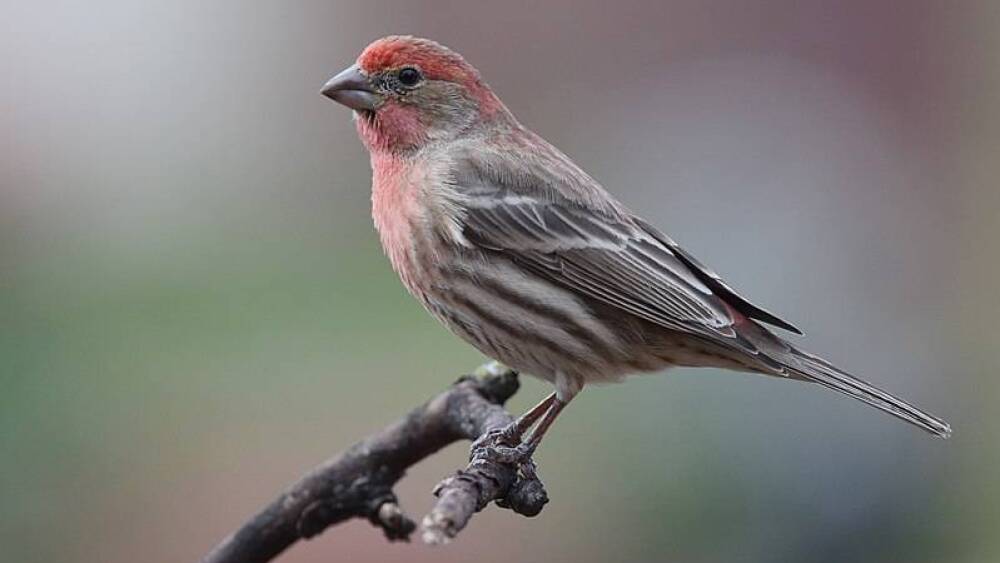Hear that outside? With the nonstop chiming and chirping all over Asheville, this is the season to get into birdwatching. And lucky for us, NC is home to hundreds of year-round and migrating bird species, meaning there are plenty of opportunities to enjoy this joyful (and free) hobby.
In honor of our feathered friends, we’re sharing 20 of the birds you may be seeing or hearing in your backyard now — plus a few tips for perfecting your birdwatching approach.
Black-throated Green Warbler

While not typically a backyard bird, you can spot these lemon-faced beauties on the Parkway.
Photo by @ncbirdwatch
Known as a relentless songbird, this sweet, lemon-faced bird loves mountain forests and can been spotted in high branches along the Blue Ridge Parkway. Its song is distinct and sounds a bit like someone chanting, “Trees, trees, I love trees.”
Ruby-Throated Hummingbird

This jewel-colored critter is eastern North America’s sole breeding hummingbird.
Photo by @ncbirdwatch
This zippy, compact bird is often described as jewel-like, because of its vibrant shades of green and red. You can help beckon this bird into your yard with a flower garden. Fun fact: this bird is eastern North America’s sole breeding hummingbird. In early fall, they migrate to Central America.
Tree Swallows

Tree Swallows love to chat.
Photo by @ncbirdwatch
These handsome, chipper blue birds are often the first spring migrants to arrive in the Blue Ridge Mountains each year. These birds are also known for having acrobatic flight patterns (especially when chasing down bugs). You can often find them nesting in tree cavities, with a song that’s high-pitched and split into three sounds: a chirp, whine, and gurgle.
American Goldfinch

This bird is a permanent resident of the mountainous area of NC.
Photo by Ken Thomas
This bird has an unusual habit of being a late nester, waiting until July or August, and Goldfinches typically nest in brushy habitats like old fields or thickets. During other seasons, you’ll find them in backyards, weedy fields, open woods, and feeding on seeds high in trees like sweetgum. Its song is a twitter and warble, with one call sounding like “po-ta-to-chip.”
Carolina Chickadee

The Chickadee particularly likes a few conifers in the forest.
Photo by Dan Pancamo
This plump songbird is one of the few in the state that’s entirely nonmigratory — you’ll find it in mature forests and woodlots, residential spaces, and remote areas. Its song is a rapid “chickadee-dee-dee.”
Carolina Wren

Despite its friendly roundness, the Wren sings out aggressively for its territory.
Photo by Ken Thomas
The chunky bird has a round body and long tail of a reddish-brown palette. They creep around vegetated areas and tree trunks, yards and woodpiles. They use their pugnacious song to defend their territory, reproaching and chasing away intruders.
Eastern Bluebird

The bright hue is unmistakable.
Photo by Dehaan
Perching on trees, posts, powerlines, and fences is where you might find this bright avian — they like grassy areas and habitats with nearby open woods. Its low-pitched “tu-a-wee” has a petulant tone.
Eastern Phoebe

The plump Eastern Phoebe gets its name from its song.
Photo by Andrew Cannizzaro
This tail-wagging bird is the only flycatcher species that regularly winters in NC, and it frequently nests on rafters of houses and buildings. They also like nesting on rock ledges and around farms. In the spring, you can hear the song that gives them their name: a raspy “fee-bee.”
Eastern Screech-Owl

These nocturnal birds only occasionally show themselves during the daylight.
Photo by Dick Daniels
The smallest of NC’s owl residents, the Eastern Screech Owl likes healthy forests, nesting in holes in trees. Mostly, they roost during the day and hunt at night, but they sometimes make an appearance when the sun is out. Pro tip: Listen for its distinctive whinnying call at night.
Eastern Towhee

Look low when you search for this little guy.
Photo by Andy Reago + Chrissy McLarren
The striking bird can be quite hard to spot — it’s a bird of the undergrowth. You’ll more likely hear its loud rummaging noise on the forest floor or its call of “chewink.”
Great Blue Heron

These big birds are hard to miss.
Photo by Mike Baird
The largest heron in North America and often called a “crane,” this wading bird is a familiar sight with a squawking and clucking call. Pro tip: Look for this leggy bird around or in bodies of water, like the French Broad.
House Finch

The bird and its twittering song are frequent feeder visitors.
Photo by Andy Reago + Chrissy McClarren
First appearing in NC in the 1960s, these birds nest in shrugs and low vegetation. Its call is a sharp cheep while perched and in flight (flush from the ground, it might get a little sharper).
Northern Cardinal

Northern Cardinals love a feeder.
Photo by Dominic Sherony
This bright red beauty is the official state bird of North Carolina and is abundant across the state during all seasons. They can be found in most forests and woodlands, wooded borders, and residential areas. The clear song is usually a string of two-parted whistles and a slow trill — like “cheer, cheer, cheer.”
Pileated Woodpecker

The bird’s red head is distinctive.
Photo by Sheila Brown
A resident of extensive and often damp forests as well as some wooded residential areas, this large woodpecker makes itself known will its loud drilling. You can also hear its song — a high, clear piping call.
Red-Tailed Hawk

You may also hear a shrill “chwirk.”
Photo by U.S. Fish and Wildlife Service
Keep an eye out for the oft-seen hawk on telephone poles along highways and over open fields — you’ll know it by its large, stocky body and mottled brown feathers. Listen for a screaming “kee-ee-arr.”
Red-Winged Blackbird

Listen for the matter-of-fact note turning into a trill.
Photo by Alan D. Wilson
A year-round bird that appears in all 100 counties of NC (but more scarce in our mountains in winter time), it likes grasses in farmlands for nesting territory. Its call is distinctive, abrupt “check.”
Song Sparrow

The Song Sparrow first nested in the NC mountains in the 1890s.
Photo by Becky Matsubara
One of the most abundant species in all of North America, the bird spends its winters and breeding season in our area. Here in the mountains, you’ll find it in farmyards, open residential areas, and shrubby sites. Its loud, clanking song ends with a trill.
Tufted Titmouse

We particularly love the tufts on the top of their heads.
Photo by @cmesker
These little birds can be found year-round here in most hardwood forests and often in residential areas. Listen for a scratchy “tsee-day-day-day” that sounds similar to a Chickadee.
Turkey Vulture

The Turkey Vulture doesn’t have the same vocal organs as other birds, so their calls sound a little different.
Photo by Peter K. Burian
The scavenger of the skies are often seen soaring or scavenging in fields or on roadsides — but they prefer to nest in hollow stumps or remote woods. They mostly call with a guttural hiss or nasal whine.
Wood Thrush

Pro tip: You’ll likely hear the beautiful song of the wood thrush in summertime forests, but you may never glimpse it.
Photo by Andy Reago + Chrissy McLarren
With a declining population, this bird has been deemed a conservation priority. It also spends its winter down in Central America — but you may not even see it in the spring because of its reclusive nature. Listen instead for its unique duet of a song.
There’s an app for that
Websites + apps have made birdwatching more accessible than ever. Here are a few we recommend:
- Merlin is a free identification app from the Cornell Lab of Ornithology that includes photos, an identification + browsing tool, and a database of songs and calls for every bird you’re likely to come across in your area. Pro tip: Merlin has a sound ID. You just click “record” in the app and aim it out at the bird(s) that are chirping/singing, and it gives you who the bird is.
- ebird.org is also from the Cornell Lab of Ornithology and is a valuable website for birders to find birds, keep track of bird lists, explore the latest sightings, and contribute to science. The best part of ebird is the hotspots locator. Asheville has 20+ local spots where birders have seen more than 100 species.
- Carolina Bird Club includes all of the bird species recorded in NC, as well as information on habitat, breeding, and abundance levels.
- North Carolina Wildlife Resources Commission provides resources for birders, including trail maps, birdwatching checklists, and a guide to how to build your own birdhouses + feeders.
- Audubon North Carolina offers state-specific information on species, conservation, resources and tips for birdwatching, and bird-friendly gardening.
B(u)y the book
Armed with a good field guide, a little knowledge can go a long way. Here are a few of our favorite books:
- The Sibley Guide to Birds by David Allen Sibley
- Peterson Field Guide to Birds by Roger Tory Peterson
- The Kaufman Field Guide to Birds of North America by Kenn Kaufman
- Birds of the Carolinas by Stan Tekiela
Join the club
Since WNC is such a hotspot for birders, there are several ways to get involved with birdwatching and other activities like bird banding.
- Blue Ridge Audubon Club is a chapter of the National Audubon Society that covers Buncombe + the surrounding counties. Visit the events calendar to find weekly bird outings.
- Carolina Bird Club is a state-wide group with meetups from the mountains to the coast (and some international trips).
- Wild Bird Research Group is a bird conservation, tracking, and banding operation with a center at the North Carolina Arboretum and has occasional volunteer opportunities for people interested in bird banding. Pro tip: Follow their gorgeous Instagram.
Look closer with binoculars
You could spend some hard coin on binoculars – and you should spend what you can afford – but there’s no reason to spend $1,000+ on optics unless you get seriously into the hobby. Bins are important, though, so you should invest in something that will give you the best experience. This hobby is all about visuals and listening. It’s hard to see the birds if you can’t see the birds, right? Here are some good binoculars + scopes:










